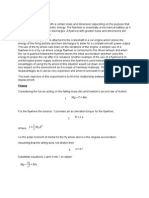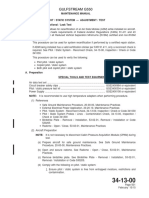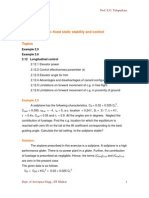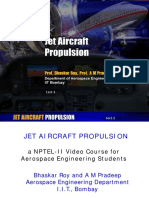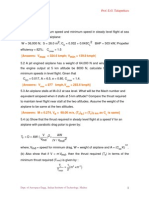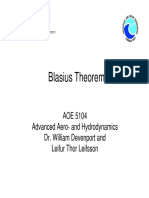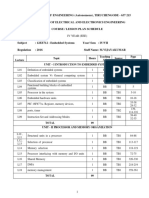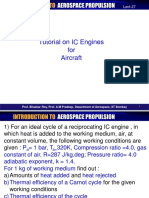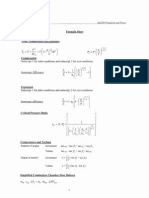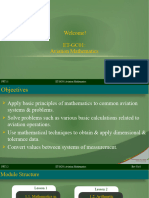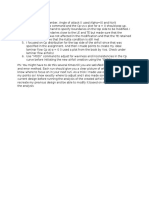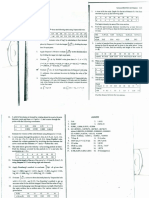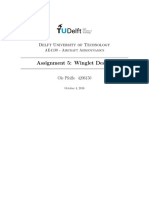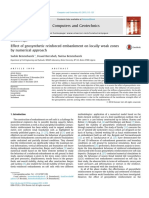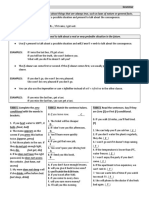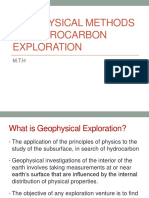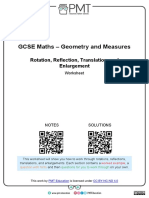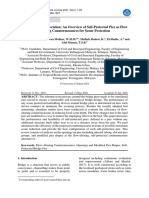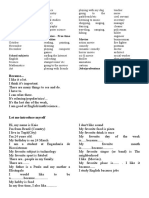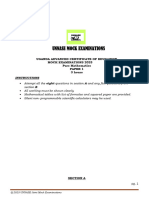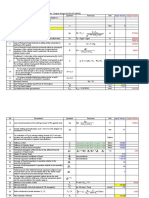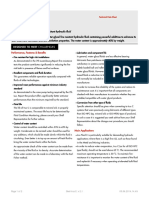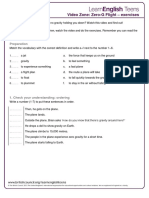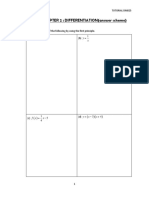Aircraft Performance Tulapurkara
Aircraft Performance Tulapurkara
Uploaded by
KISHORKUMAR UKIRDECopyright:
Available Formats
Aircraft Performance Tulapurkara
Aircraft Performance Tulapurkara
Uploaded by
KISHORKUMAR UKIRDECopyright
Available Formats
Share this document
Did you find this document useful?
Is this content inappropriate?
Copyright:
Available Formats
Aircraft Performance Tulapurkara
Aircraft Performance Tulapurkara
Uploaded by
KISHORKUMAR UKIRDECopyright:
Available Formats
Flight dynamics –II Prof. E.G.
Tulapurkara
Stability and control
Chapter 3
Lecture 13
Longitudinal stick–free static stability and control – 2
Topics
3.3.4 Shift in neutral point by freeing the stick
Example 3.1
Example 3.2
3.4 Stick force and stick force gradient
3.4.1 Dependence of stick force on flight velocity and airplane size
3.4.3 Tab deflection for zero stick force
3.3.4 Shift in neutral point by freeing the stick
The shift in neutral point by freeing the stick is given by :
'
xNP xNP C dε
- = (1 - f) Lαt VH η(1 - ) (3.16)
c c CLαw dα
Example 3.1
Obtain the shift in the neutral point for the airplane in example 2.4. The
values of some of the parameters are: VH = 0.738, η = 0.9, CLαw = 4.17 rad-1,
CLαt = 3.43 rad-1, dε/dα = 0.438. Assume = 0.5, Chδe = - 0.005 deg-1,
Chαt = - 0.003 deg-1. Substituting various values in Eq.(3.16) yields:
-0.003
f = 1- 0.5( ) = 1- 0.3 = 0.7 and
-0.005
'
xNP xNP 3.43
- = (1 - 0.7)× × 0.738× 0.9 (1 - 0.438) = 0.0921
c c 4.17
Remarks:
i) In this case, by freeing the stick, the neutral point has shifted forward by
0.0921 c or the static margin has decreased by 0.0921. In other words
Cmα - Cmα = - 0.0921CLα
Dept. of Aerospace Engg., IIT Madras 1
Flight dynamics –II Prof. E.G. Tulapurkara
Stability and control
Chαt
ii) If Chαt is positive and Chδe is negative then (1- ) can become more that
Chδe
one and stability will increase on freeing the stick. It is explained in
subsection 3.4.4 that for proper variation of stick force gradient, Chδe should have
a small negative value. Control of Chαt within narrow limits is difficult and
generally Chαt and Chδe have small negative values.
Example 3.2
An airplane has the following characteristics.
CLαw = 0.085 deg-1, CLαt = 0.058 deg-1, dCL/dδe = 0.032, Chαt = -0.003 deg-1,Chδt =
-0.0055, iw = 0, α0L = -20 , it = -10, ε = 0.5 α, St = 0.25 S, lt = 3 c , W/S =1500 N/m2 ,
a.c. location = 0.25 c , η = 1.0, (Cmα)f,n,p = 0.37 rad-1.
Obtain
i) Stick-fixed neutral point
ii) Stick-free neutral point
iii) Stick -free neutral point when Chαt is changed to 0.003.
Solution:
The given data is:
CLαw = 0.085, CLαt = 0.058, dCLt /dδe = 0.032
Chδe = - 0.0055,Chαt = -0.003
iw = 0, α0L = - 20 ,it = - 10 , ε = 0.5 α,
St = 0.25S, lt = 3 c, a.c. at 0.25 c,
η = 1.0, (Cmα )f,n,p = 0.37 rad-1
CLαw = 0.085 deg-1 = 4.87rad-1
CLαt = 0.058 deg-1 = 3.323 rad-1
dε S l
= 0.5, VH = t t = 0.25×3 = 0.75
dα S c
= CLδe / CLαt = 0.032 / 0.058 = 0.552
(i) Stick-fixed neutral point:
Dept. of Aerospace Engg., IIT Madras 2
Flight dynamics –II Prof. E.G. Tulapurkara
Stability and control
xNP x ac 1 C dε
= - (Cmα )f,n,p + η VH Lαt (1 - )
c c CLαw CLαw dα
1 3.323
= 0.25 - ×0.37+ 1.0 × 0.75 × (1 - 0.5)
4.87 4.87
= 0.25 - 0.0759 + 0.256 = 0.4301
(ii) Stick-free neutral point:
xNP xac 1 C dε C
= - (Cmα )f,n,p + η VH Lαt (1- )(1- hαt )
c c CLαw CLαw dα Chδe
-0.003
= 0.25 - 0.0759 + 0.256 {1- 0.552 ( )}
-0.0055
= 0.25 - 0.759 + 0.181 = 0.355
(iii) Stick-free neutral point when Chαt = 0.003
x'NP 0.003
= 0.25 - 0.0759 + 0.256 {1-0.552 ( )}
c -0.0055
= 0.25 - 0.0759 + 0.331 = 0.5051
3.4 Stick force and stick force gradient
Figure 3.1 shows the schematic of the control surface, the control stick,
the hinge moment (He) due to pressure distribution and the stick force (F). As
mentioned earlier, a nose up hinge moment is taken as positive. The convention
for the stick force is that a pull force at the stick is taken as positive.
The relation between F and He is given by :
1 2
F = GHe = G ρV η Se c e Che (3.17)
2
where, G is the gearing ratio. It may be pointed out that G is not dimensionless; it
has the dimension of m-1.
Recall that:
Che = Chαt αt + Chδe δe + Chδt δt (3.4)
CL dε
αt = α0Lw + it - iw + (1- ) ; CL CLW (2.44)
CLαw dα
dCm 1
( )stick-fix = (Cmα )stick-fix (2.71)
dCL CLαw
Dept. of Aerospace Engg., IIT Madras 3
Flight dynamics –II Prof. E.G. Tulapurkara
Stability and control
1 dCm
δtrim = δe0CL - ( )stick-fix CL (2.84)
Cmδe dCL
Substituting from Eqs.(2.44),(2.71)and (2.84) in Eq.(3.4) yields :
CL dε C dCm
Che =Chαt {α0Lw + it -iw + (1- )}+ Chδt δt + Chδe δe0CL - hδe ( )stick-fixCL (3.19)
CLαw dα Cmδe dCL
Rearranging yields:
Chδe dC
Che = [Chαt (α0Lw + it - iw )+ Chδe δe0CL ] + Chδt δt - CL [( m )stick-fix
Cmδe dCL
Cmδe Chαt dε
- (1- )] (3.20)
Chδe CLαw dα
Substituting Cmδe = -VH ηt CLαt , gives :
dCm C C dε
( )stick-fix - mδe hαt (1- )
dCL Chδe CLαw dα
dCm C 1 dε
=( )stick-fix + VH ηt CLαt hαt (1- ) (3.21)
dCL Chδe CLαw dα
dCm
From Eq.(3.14a) the r.h.s of Eq.(3.21) is ( )stick-free
dCL
Substituting from Eq.(3.21) in Eq.(3.20) gives:
Chδe dC
Che = A + Chδt δt - CL ( m )stick-free (3.22)
Cmδe dCL
where, A = Chαt (α0Lw + it - iw ) + Chδe δe0CL (3.23)
W
Substituting, from Eq.(3.22) in Eq.(3.17) and noting CL = , yields :
1 2
ρV S
2
1 C W dC
F=G ρ V 2 η Se c e {A + Chδt δt - hδe ( m )stick-free }
2 Cmδe 1 ρV 2S dCL
2
1 W Chδe dCm
Or F = K ρV 2 {A + Chδt δt } - K ( )stick-free (3.24)
2 S Cmδe dCL
where, K = G η Se c e (3.25)
F C dC 1
Or = G η Se c e {A + Chδt δt - hδe CL ( m )stick-free }; q = ρ V 2 (3.26)
q Cmδe dCL 2
Dept. of Aerospace Engg., IIT Madras 4
Flight dynamics –II Prof. E.G. Tulapurkara
Stability and control
d( F ) C dC
q
Hence, = - GηSe c e hδe ( m )stick-free (3.27)
dCL Cmδe dCL
3.4.1 Dependence of stick force on flight velocity and airplane size
The first term in Eq.(3.24) depends on V2 and hence, the stick force
increases rapidly with flight speed. The constant K in Eq. (3.24) involves the
product Se c e in it. The quantities c e and Se are roughly proportional to the linear
dimension of the airplane and its square respectively. Thus, the product Se c e is
proportional to the cube of the linear dimension of the airplane. Hence, the
control force which depends on Se c e could be very large for large airplanes.
Manual control is not possible in such cases (see section 6.12).
3.4.2 Tab deflection for zero stick force
In section 3.1 it was noted that the stick force can be made zero by proper
tab deflection. An expression for this deflection is obtained below.
Consider the second term in Eq.(3.24). Noting that (a) Chδe is generally
negative (see section 3.4.4), (b) Cmδe is negative and (c) (dCm / dCL)stick-ree is
negative for a stable airplane, the second term in Eq.(3.24) is positive for a stable
airplane. Further, the first term in Eq.(3.24) depends on V and δt. Hence, at a
given V, the stick force can be reduced to zero by proper choice of δt (Fig.3.5).
The operation of making stick force zero by proper tab deflection, is called
trimming the stick. Equating r.h.s. of Eq.(3.24) to zero yields (δt)trim for chosen
Vtrim i.e.
1 W Chδe dCm
0=K ρ Vtrim
2
{A + Chδt (δt )trim } - K ( )stick-free
2 S Cmδe dCL
W
1 Chδe S ( dCm )
Or (δt )trim =- {A - stick-free } (3.28)
Chδt 1
Cmδe ρV 2 dCL
trim
2
Differentiating Eq.(3.28) with CL yields :
Dept. of Aerospace Engg., IIT Madras 5
Flight dynamics –II Prof. E.G. Tulapurkara
Stability and control
d(δt )trim Chδe 1 dCm
= ( )stick-free (3.29)
dCL Chδt Cmδe dCL
Substituting δtrim from Eq.(3.28) in Eq.(3.24) , the stick force becomes:
W Chδe dCm V2
F=K ( )stick-free ( 2 -1) (3.30)
S Cmδe dCL Vtrim
Fig.3.5 Variation of stick force with velocity for different tab deflections-schematic
3.4.3 Stick force gradient
The stick force gradient is defined as dF/dV. Differentiating Eq.(3.30) with
V gives:
dF W Chδe dCm V
= 2K ( )stick-free 2 (3.31)
dV S Cmδe dCL Vtrim
dF
When V = Vtrim, the stick force gradient, ( )trim , is :
dV
dF W Chδe dCm 1
( )trim = 2K ( )stick-free (3.32)
dV S Cmδe dCL Vtrim
Figure 3.5 shows the variation of the stick force with V and the gradient (dF/dV)
at V = Vtrim. See example 3.3.
Dept. of Aerospace Engg., IIT Madras 6
You might also like
- 04 - Chapter 5Document16 pages04 - Chapter 5Sahiel HaripersadNo ratings yet
- Drag Polar Assignment - Nathan Cook P4096835Document9 pagesDrag Polar Assignment - Nathan Cook P4096835Anonymous 2iMBk59NXLNo ratings yet
- ENGR6012 Assignment #1: Mechanical Vibrations and Condition MonitoringDocument8 pagesENGR6012 Assignment #1: Mechanical Vibrations and Condition MonitoringUsama Mughal0% (1)
- Bài 5 - Lateral Motion (Stick Fixed) (2008)Document12 pagesBài 5 - Lateral Motion (Stick Fixed) (2008)neiht_ksNo ratings yet
- Lesson 18 - Et332b.ppsxDocument14 pagesLesson 18 - Et332b.ppsxAbdalla AlfakiNo ratings yet
- Flywheel ExperimentDocument4 pagesFlywheel ExperimentNasim Mammadov67% (3)
- Maintenance ManualDocument18 pagesMaintenance ManualAdrian Lau100% (1)
- 012 - Chapter 2 - L10Document12 pages012 - Chapter 2 - L10nanduslns07No ratings yet
- Lect 1Document23 pagesLect 1Muhammad Hussain100% (1)
- 07 - Chapter 9Document6 pages07 - Chapter 9Sahiel HaripersadNo ratings yet
- Solution:: CoolerDocument5 pagesSolution:: CoolerBOTU ROHITHNo ratings yet
- Template CEP ReportDocument8 pagesTemplate CEP ReportHassan KhanNo ratings yet
- Turbojet EngineDocument1 pageTurbojet EnginenanthakumarmaniNo ratings yet
- Re-Appropriation of Funds of Rs.3.99 Lakh Under Grant No 97 Dispatch No.27-05Document1 pageRe-Appropriation of Funds of Rs.3.99 Lakh Under Grant No 97 Dispatch No.27-05Ashish Singh Negi100% (1)
- Exercises: Flight Dynamics-I Prof. E.G. Tulapurkara Chapter-5Document1 pageExercises: Flight Dynamics-I Prof. E.G. Tulapurkara Chapter-5Chegrani AhmedNo ratings yet
- Ex 2Document2 pagesEx 2api-3708873No ratings yet
- Blasius TheoremDocument9 pagesBlasius TheoremAhmed Assaf100% (1)
- Embedded SystemDocument28 pagesEmbedded Systemnanobala15No ratings yet
- Beer Ch13 Prob Sol 02Document23 pagesBeer Ch13 Prob Sol 02SH YeoNo ratings yet
- Control Systems Theory: Transfer Function of Physical Systems STB 35103Document108 pagesControl Systems Theory: Transfer Function of Physical Systems STB 35103Akula Veerraju100% (1)
- Ofwacoustics PDFDocument41 pagesOfwacoustics PDFMike BrynerNo ratings yet
- 1 D Link Analysis of A Tapered Bar Using ANSYSDocument21 pages1 D Link Analysis of A Tapered Bar Using ANSYSAdityaChaurasiyaNo ratings yet
- Introduction To The Method of Characteristics and The Minimum Length NozzleDocument52 pagesIntroduction To The Method of Characteristics and The Minimum Length Nozzledurgesh3guptaNo ratings yet
- Lec27 Problem Solution PDFDocument22 pagesLec27 Problem Solution PDFmaya singhNo ratings yet
- Engineering Mechanics Assignment 4 PDFDocument5 pagesEngineering Mechanics Assignment 4 PDFRaja Sekhar KonathamNo ratings yet
- M002-Cartesian State Vectors To Keplerian Orbit ElementsDocument2 pagesM002-Cartesian State Vectors To Keplerian Orbit ElementsFaisalNo ratings yet
- Aerodynamics 2marks PDFDocument11 pagesAerodynamics 2marks PDFPrapanjan KumaranNo ratings yet
- Aerodynamics II Lecture NotesDocument17 pagesAerodynamics II Lecture NotesSuman.S100% (1)
- Propulsion and Power Formula SheetDocument4 pagesPropulsion and Power Formula SheetArun VinthanNo ratings yet
- Power Requirements of A VehicleDocument32 pagesPower Requirements of A VehicleAvinashRaiNo ratings yet
- ET-GC01 Mathematics PPT Final R0Document105 pagesET-GC01 Mathematics PPT Final R0Omar AdamNo ratings yet
- Xfoil Mdes TutorialDocument1 pageXfoil Mdes TutorialOzichukwu OsakweNo ratings yet
- Astable MultivibratorDocument4 pagesAstable MultivibratorWaldo Pulanco100% (1)
- Model Question Paper-1 With Effect From 2020-21 (CBCS Scheme)Document10 pagesModel Question Paper-1 With Effect From 2020-21 (CBCS Scheme)TANUJIT MONDALNo ratings yet
- Exp 3 Themodynamic Functions 21BCE1297 Vidhi ShahDocument11 pagesExp 3 Themodynamic Functions 21BCE1297 Vidhi ShahVidhi ShahNo ratings yet
- Fundamentals of Helicopter Dynamics by Venkatesan, C (Z-Lib - Org) - 1Document27 pagesFundamentals of Helicopter Dynamics by Venkatesan, C (Z-Lib - Org) - 1Anonymous b14XRyNo ratings yet
- Objective Type Questions Instrumentation System & Devices (IDS)Document7 pagesObjective Type Questions Instrumentation System & Devices (IDS)mail2jaleel9952No ratings yet
- Numerical Integration NewDocument2 pagesNumerical Integration NewBabar KhanNo ratings yet
- EAT 339 Jan 2023 TCT QuestionsDocument10 pagesEAT 339 Jan 2023 TCT QuestionsOji Ifeanyi0% (1)
- Solutions:: 7.3 Electronic Polarization in Liquid XenonDocument14 pagesSolutions:: 7.3 Electronic Polarization in Liquid XenonMukesh KumarNo ratings yet
- Antenna Synthesis ReportDocument10 pagesAntenna Synthesis Reportesraahabeeb63No ratings yet
- Bài 4 - Longitudinal Motion (Stick Fixed) (2008)Document32 pagesBài 4 - Longitudinal Motion (Stick Fixed) (2008)Tuan Anh PhamNo ratings yet
- AE2030 - Fatigue and FractureDocument1 pageAE2030 - Fatigue and FractureArun Raja K K100% (1)
- Engineering Mechanics Lab ManualDocument5 pagesEngineering Mechanics Lab Manualउमेश गावंडे100% (1)
- Formula Sheet For Free VibrationDocument5 pagesFormula Sheet For Free VibrationCesar MolinaNo ratings yet
- CPCS 222 Discrete Structures I Boolean AlgebraDocument54 pagesCPCS 222 Discrete Structures I Boolean AlgebraAmong AssNo ratings yet
- Matlab Script of Four Bar Linkage - Google DriveDocument3 pagesMatlab Script of Four Bar Linkage - Google DriveJulendra AriatedjaNo ratings yet
- Assignment 5Document14 pagesAssignment 5OleNo ratings yet
- Module 2 - Basic AerodynamicsDocument26 pagesModule 2 - Basic AerodynamicsMadelar, Arc Francis C.No ratings yet
- Practice 6 - 2D SketchDocument2 pagesPractice 6 - 2D SketchPhúc Lê Huỳnh Hoàng100% (1)
- Btech 3 Sem Sensor and Instrumentation Koe034 2020Document2 pagesBtech 3 Sem Sensor and Instrumentation Koe034 2020Atharv SinghNo ratings yet
- Assignment Fifth SemDocument13 pagesAssignment Fifth SemismaelNo ratings yet
- Physics: Lab 03Document6 pagesPhysics: Lab 03Hamza QureshiNo ratings yet
- Missile ForcesDocument4 pagesMissile ForcesPrasanna Balaji100% (1)
- AE3301 EAE Model QPDocument2 pagesAE3301 EAE Model QPVivekananda Subramani100% (1)
- MP2002-Tut 1Document5 pagesMP2002-Tut 1Ashwin Kumar ChandranNo ratings yet
- Project Mom ReportDocument18 pagesProject Mom ReportIhtesham ArifNo ratings yet
- 017 - Chapter 3 - L13Document6 pages017 - Chapter 3 - L13nanduslns07No ratings yet
- Longitudinal Stick-Fixed Static Stability and Control TopicsDocument12 pagesLongitudinal Stick-Fixed Static Stability and Control Topicssameh hassanNo ratings yet
- 02 045 FDSDocument8 pages02 045 FDSJaveria NaseemNo ratings yet
- Secret Saturday Jumpchain 2.0Document19 pagesSecret Saturday Jumpchain 2.0tvo770No ratings yet
- Summary: PC1144, Introduction To Modern PhysicsDocument41 pagesSummary: PC1144, Introduction To Modern PhysicsShan Yu XuanNo ratings yet
- Be - Mechanical Engineering - Semester 7 - 2023 - May - Dynamics of Machinery Dom Pattern 2019Document3 pagesBe - Mechanical Engineering - Semester 7 - 2023 - May - Dynamics of Machinery Dom Pattern 2019shubham kumbharNo ratings yet
- 1 s2.0 S0266352X14002328 MainDocument11 pages1 s2.0 S0266352X14002328 MainYOGESH KUMAR SHARMANo ratings yet
- Grammar Week 9Document3 pagesGrammar Week 9ASLY CAMILA SOLARTE DELGADONo ratings yet
- Geophysical Methods of Hydrocarbon ExplorationDocument30 pagesGeophysical Methods of Hydrocarbon ExplorationAshrafNo ratings yet
- RRB Je 24Document48 pagesRRB Je 24nglprojectsNo ratings yet
- F. Rotation, Reflection, Translation and EnlargementDocument33 pagesF. Rotation, Reflection, Translation and Enlargementthi tar lwinNo ratings yet
- Physics Paper 3 TZ1 SL PDFDocument9 pagesPhysics Paper 3 TZ1 SL PDFPalaash GoyalNo ratings yet
- ByStar Fiber Datasheet Eng Original 14278Document2 pagesByStar Fiber Datasheet Eng Original 14278Trần Ngọc ThànhNo ratings yet
- Bridge Failure Prevention An Overview of Self-Protected Pier As Flow Altering Countermeasures For Scour ProtectionDocument22 pagesBridge Failure Prevention An Overview of Self-Protected Pier As Flow Altering Countermeasures For Scour ProtectionAlexDeLacRuzNo ratings yet
- Introduce YourselfDocument1 pageIntroduce YourselfKaio Junior Pinheiro OliveiraNo ratings yet
- Hfss ThesisDocument6 pagesHfss Thesisfjn3d3mc100% (2)
- Check of Anchors According To STO - IDEA StatiCaDocument8 pagesCheck of Anchors According To STO - IDEA StatiCamehmetmehmetmehmet111111No ratings yet
- S 700Document12 pagesS 700HeiderHuertaNo ratings yet
- Course Ouline SIT 064Document3 pagesCourse Ouline SIT 064abuumaiyoNo ratings yet
- Experiment. No. 4: Title of Experiment Equipment UsedDocument8 pagesExperiment. No. 4: Title of Experiment Equipment UsedHojoborolo ApuNo ratings yet
- Potential and CapcitanceDocument57 pagesPotential and CapcitanceAnushkaNo ratings yet
- Phases of MatterDocument6 pagesPhases of Matterregine13 iki100% (1)
- 2023 Unnase Math p1 s6Document3 pages2023 Unnase Math p1 s6killervibz3No ratings yet
- Calculation - Cylinder Head BoltsDocument7 pagesCalculation - Cylinder Head BoltsRavisatya DasamNo ratings yet
- GPCDOC GTDS Shell Irus C (En) TDSDocument2 pagesGPCDOC GTDS Shell Irus C (En) TDSDenny BayuajiNo ratings yet
- 22-23 DCE & DMT What To Be Write in FEEE ExamDocument23 pages22-23 DCE & DMT What To Be Write in FEEE ExamV VikasNo ratings yet
- Specs - Steel Poles & AccessoriesDocument31 pagesSpecs - Steel Poles & AccessoriesmohamedNo ratings yet
- Zero-G Flight - Exercises 0Document3 pagesZero-G Flight - Exercises 0Ritha Cruz KANo ratings yet
- Unit-1 LDE Notes CivilDocument19 pagesUnit-1 LDE Notes CivilYashraj Kajave100% (1)
- Capillary Pressure of Van Der Waals Liquid NanodropsDocument3 pagesCapillary Pressure of Van Der Waals Liquid NanodropsMihail AvramovNo ratings yet
- Tuto Topik 2Document14 pagesTuto Topik 2izzat farhanNo ratings yet
- Clearing Your Self of Negative EnergyDocument1 pageClearing Your Self of Negative EnergySarah BennettNo ratings yet





